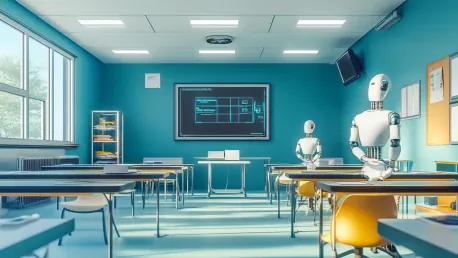In today’s rapidly evolving educational landscape, K-12 schools face numerous challenges such as teacher shortages, operational inefficiencies, and maintaining student engagement. With the advent of artificial intelligence (AI) and smart technologies, there’s a transformative potential to address these issues. A webinar hosted by CDW titled “Accelerating K-12 Education: Empowering Classrooms with Smart Solutions and AI” is set to explore these possibilities.
The Potential of AI in K-12 Education
Revolutionizing Administrative Tasks
One of the most time-consuming aspects of teaching involves administrative duties that can detract from instructional time. AI tools like Microsoft Teams and Copilot are poised to revolutionize how teachers manage these tasks, offering solutions that streamline the preparation and assessment workloads. According to Mark Sparvell, Director of Education Marketing for Microsoft, these advancements can significantly decrease the hours teachers dedicate to routine administrative duties, thereby allowing them to focus more on direct student interaction and engagement, which are essential for effective education.
By leveraging AI, teachers can automate several aspects of lesson planning and student assessments. This not only reduces the monotony associated with these tasks but also ensures higher accuracy and efficiency. AI applications can generate personalized resources, grade assignments, and provide detailed feedback with minimal input from the teacher. Such innovations can transform the teaching landscape, allowing educators to devote their time and energies to creating a more dynamic and engaging classroom environment.
Personalized Learning Experiences
Artificial Intelligence is not just a time-saver for teachers but also a powerful tool for creating personalized learning experiences that can cater to the needs of individual students. AI tools embedded in educational platforms can analyze data to understand each student’s unique learning preferences, strengths, and weaknesses. They can then offer tailored learning paths, providing resources that align with each student’s pace and style of learning.
AI technologies can act as “endlessly patient tutors,” offering support and resources that help students grasp difficult concepts without additional manual input from teachers. For example, Microsoft Copilot can help create specialized assessments and learning materials for English language learners, which makes instruction more inclusive and effective. Such personalized learning aids ensure that students receive the individualized attention they need to succeed academically while freeing teachers to oversee and guide the overall learning process rather than get bogged down by the minutiae of customization.
Enhancing Operational Efficiency
Self-Service Technology Solutions
Operational efficiency within schools is another critical area where AI and smart technologies can make a significant impact. James Symons, CEO of LocknCharge, discusses innovative self-service tools designed to minimize downtime for student devices. These tools empower students to manage minor tech issues independently, eliminating the need for constant teacher or IT intervention. Such self-service solutions ensure that learning is not frequently disrupted by technical hitches, thus promoting a smoother and more continuous educational experience.
Implementing self-service technologies can alleviate the administrative burdens placed on teachers, media specialists, and IT staff. When devices malfunction, students can use simple, intuitive systems to resolve common issues on their own, thereby ensuring they maintain access to essential learning resources. This also helps cultivate problem-solving skills among students, making them more self-reliant. By reducing the frequency of these interruptions and empowering students to handle basic troubleshooting, schools can ensure that educators and support staff concentrate more on instructional and strategic responsibilities.
Reducing Workload on School Staff
The integration of AI and other technologies that support operational efficiency can drastically reduce the workload on school staff. Teachers, media specialists, and IT staff often spend considerable time troubleshooting device issues, which can detract from their core educational responsibilities. By adopting AI-driven, self-service technology solutions, schools can streamline these processes and redirect the focus of their staff towards more impactful educational activities.
With technology capable of handling essential yet time-consuming tasks, the administrative load on educational staff is significantly lightened. This not only contributes to a more productive academic environment but also boosts overall morale and job satisfaction among the staff. Such efficiencies can lead to an even more focused and engaged teaching community, which directly benefits students. Schools that embrace these innovations are better positioned to manage resources and time effectively, ensuring both teachers and students can concentrate on what truly matters—learning and academic growth.
Integrating Interactive Technologies
Post-Pandemic Student Engagement
Maintaining student engagement in a post-pandemic world presents unique challenges, and interactive technologies are proving to be crucial tools in this regard. Interactive displays, for instance, have emerged as vital for capturing and sustaining student attention in ways that traditional methods often cannot. James Gaffikin from SMART Technologies points out that these interactive displays allow for a hands-on approach to learning, making lessons more dynamic and stimulating. This technology is particularly effective in re-engaging students who have become accustomed to passive learning during periods of remote education.
Interactive displays facilitate an immersive learning environment where students can actively participate in their education. By allowing students to interact with the content directly, these tools make learning more engaging and enjoyable. They also support various learning styles, catering to visual, auditory, and kinesthetic learners. The post-pandemic educational shift towards technology-enhanced learning has highlighted the importance of such interactive platforms in maintaining high levels of student engagement and participation.
Seamless Educational Tools
The effectiveness of interactive displays is further amplified when integrated with sophisticated educational platforms like SMART’s Lumio. These platforms offer pre-made templates and lessons, enabling teachers to customize their instructional materials quickly and efficiently. This combination provides a seamless educational experience where technology seamlessly bridges the gap between teacher intention and student understanding, making the learning process more fluid and effective.
Teachers can leverage these tools to create interactive and adaptive lessons that respond to the dynamic needs of their classrooms. The ability to customize content swiftly means that educators can adapt lessons in real time based on student feedback and performance. This not only enhances the quality of education but also makes it more responsive and student-centered. By integrating tools like Lumio with interactive displays, schools can offer a technologically rich environment conducive to innovative teaching and active learning, which is essential for meeting the diverse needs of today’s students.
The Importance of Professional Development
Addressing the Training Gap
Despite the emergence of advanced educational technologies, many teachers remain underprepared to fully integrate these tools into their classrooms. Brian Beedenbender, Vice President of Sales at Teq, emphasizes that insufficient professional development can significantly undermine the potential benefits of new ed-tech tools. The gap in training means that many educators are unable to leverage these technologies to their fullest extent, resulting in suboptimal educational outcomes and missed opportunities for enhanced learning experiences.
Addressing this training gap is critical for maximizing the effectiveness of educational technology investments. Without adequate training, even the most advanced tools can fall short of their intended impact. Professional development needs to be ongoing and comprehensive, equipping teachers with the knowledge and skills required to integrate new technologies into their curricula effectively. This means shifting from one-time training sessions to continuous learning opportunities that support teachers as they adapt to rapidly changing educational technologies and methodologies.
Comprehensive Training Solutions
To bridge the training gap, Teq’s learning platform, Otis, provides a robust solution with its diverse range of professional development offerings. The platform offers synchronous, asynchronous, and one-on-one training sessions, ensuring that teachers receive the continuous, personalized support they need. This approach allows educators to familiarize themselves with new technologies at their own pace while also addressing specific challenges they may encounter in their unique classroom settings.
Such comprehensive training solutions are crucial for enabling teachers to integrate new technologies seamlessly into their teaching strategies. By participating in ongoing professional development, educators can stay abreast of the latest innovations and best practices in ed-tech. This, in turn, enhances their ability to create engaging, effective learning environments that leverage the full potential of the tools at their disposal. Investing in robust professional development is essential for schools to realize the transformative potential of educational technologies fully.
Holistic Safety Solutions in Schools
Integrated Safety Tools
Ensuring school safety is an inarguable priority, and fragmented safety tools that function in isolation can lead to inefficiencies and additional challenges. Nick Welch from Kokomo24/7 highlights the importance of integrated safety tools that work collectively to provide a more cohesive and effective approach to school security. Such tools range from visitor management systems to panic buttons and mass notification systems, all designed to work together seamlessly to enhance overall school safety.
An integrated safety platform brings together various safety tools into a unified system, ensuring that they operate in harmony. This integration enhances the ability to respond to emergencies swiftly and effectively, minimizing the potential for confusion and delays. A holistic safety approach ensures that all aspects of school security are covered, from visitor entry to emergency response, creating a safer environment for students, staff, and visitors alike.
Streamlined Safety Platforms
A holistic software platform that integrates various safety tools can provide a more streamlined approach to managing school safety. These platforms allow for efficient coordination between different safety measures, ensuring quick and coordinated responses to emergencies. Such a system enhances accountability and interoperability, making it easier for school administrators to manage safety protocols and respond to incidents promptly and efficiently.
By integrating visitor management, panic buttons, and mass notification systems into a single platform, schools can create a more cohesive and effective safety strategy. This streamlined approach ensures that all safety measures are connected and can communicate with each other, providing a comprehensive safety net. The ability to manage all aspects of school safety from a unified platform not only enhances efficiency but also ensures that schools are better prepared to handle emergencies, thereby safeguarding the well-being of students and staff.
Overarching Trends and Insights
Alleviating Teacher Workloads
One of the overarching themes emerging from discussions about educational technology is the heavy workload that teachers currently bear, working an average of 53 hours per week. AI and automation offer significant opportunities to alleviate these burdens by taking over mundane and repetitive tasks, allowing educators to devote more of their time to direct student interaction and instructional activities. This shift could be transformative for the education sector, enabling teachers to focus on what matters most—helping students learn and grow.
The potential of AI to reduce administrative workloads and streamline other time-consuming tasks cannot be overstated. By automating routine activities like lesson planning, grading, and assessments, AI can free up valuable time for teachers to engage more deeply with their students. This increased interaction can lead to improved educational outcomes, as teachers have more time to identify and address individual student needs, provide personalized support, and foster a more dynamic and inclusive learning environment.
Usability and Integration of Technologies
For educational technologies to be successful, usability and ease of integration into existing educational systems are crucial. Tools and technologies that are user-friendly and can be seamlessly incorporated into the current infrastructure are more likely to be adopted and sustained over the long term. Comprehensive professional development is vital to ensure educators can effectively use these tools, enhancing their teaching strategies and improving student learning experiences.
The usability of educational technologies extends beyond simple functionality; it includes how easily these tools can be understood and integrated into daily teaching practices. Educators need to feel confident in using new technologies, and this confidence comes from thorough training and ongoing support. When technologies are easy to use and align well with existing teaching methods, teachers are more likely to embrace them and utilize their full potential, leading to more innovative and effective educational practices.
Ensuring School Safety
In the context of educational technology, the importance of a coordinated approach to school safety cannot be overstated. Integrated safety solutions that work seamlessly together are essential for maintaining a secure and responsive school environment. This trend emphasizes the necessity of combining efficiency with safety to foster a conducive learning atmosphere where students and staff can focus on education without concerns about their security and well-being.
Developing a comprehensive safety strategy that incorporates technology requires careful planning and integration of various safety tools. Schools need to ensure that their safety measures are not only effective individually but also work together as part of a coherent and unified system. By adopting an integrated approach to school safety, educational institutions can better protect their students and staff, ensuring a safe and supportive environment conducive to learning and growth.
Conclusion
In the fast-changing educational environment, K-12 schools grapple with several hurdles including teacher shortages, inefficiencies in operations, and keeping students engaged. The rise of artificial intelligence (AI) and smart technologies presents a significant opportunity to tackle these issues effectively. A webinar titled “Accelerating K-12 Education: Empowering Classrooms with Smart Solutions and AI” organized by CDW aims to delve into these transformative possibilities. The event will discuss how AI can be leveraged to create more personalized learning experiences, streamline administrative tasks, and address the increasing burnout among educators. It will showcase real-world examples where smart technologies have been successfully integrated into classrooms to not only improve the learning process but also to make educational environments more efficient and adaptive. Participants will gain insights into how these advanced technologies can revolutionize the way education is delivered, making it more effective and sustainable in the long run. This webinar is a must-attend for educators, administrators, and policymakers who are keen on harnessing the power of AI and smart solutions to enhance the future of education.









